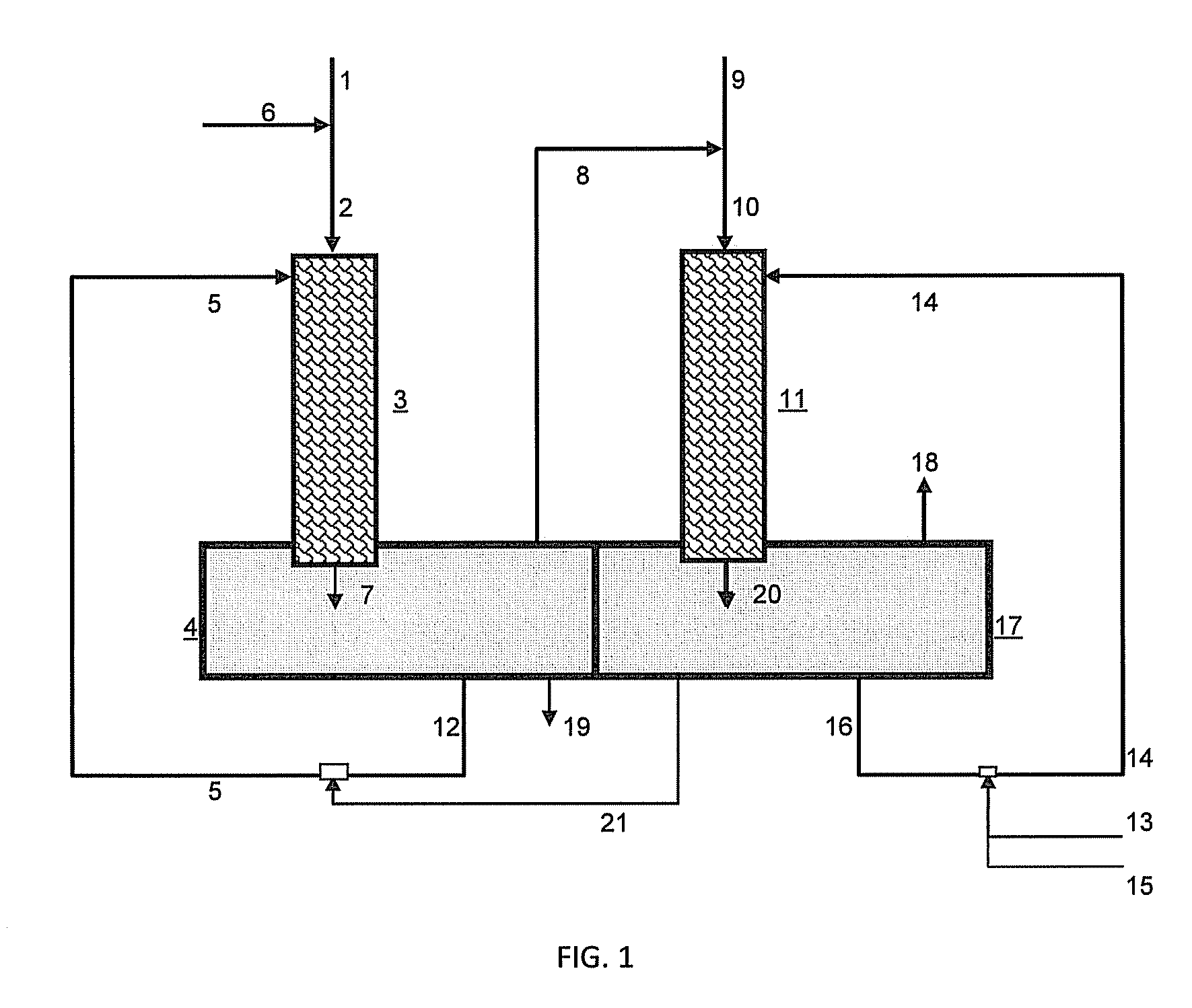Hydrocarbon Treatment Process
a hydrocarbon treatment and hydrocarbon technology, applied in the field of liquid hydrocarbon treatment, can solve the problems of complex alkylphenol extraction process and difficult principal operation, and achieve the effects of reducing entrainment, reducing entrainment, and facilitating liquid-liquid mass transfer
- Summary
- Abstract
- Description
- Claims
- Application Information
AI Technical Summary
Benefits of technology
Problems solved by technology
Method used
Image
Examples
examples
[0026]Four sets of comparison experiments are provided to demonstrate the enhanced treating efficiency of the aqueous treatment solution of our invention. In the first set, conventional caustic solutions are used to treat a sour jet fuel for sweetening. In the second set, one embodiment of our treatment solution is shown to substantially improve the treating efficiency. In the third set, five different compositions of our treatment solution are used to treat the sour jet fuel to show that the treating efficiency is further substantially improved by including a carboxylic acid.
[0027]The treating (i.e. sweetening) efficiency of a treating solution was experimentally determined in a laboratory bench-top batch reactor. A sour jet fuel feed having boiling point of 123° C. to 343° C. was obtained from a refinery plant. To each volume of an aqueous treating solution in a batch reactor, five volumes of this sour hydrocarbon were charged and the contents were mixed. The reactor content was k...
examples 1-3
[0029]In commercially practiced sweetening technologies, sodium hydroxide solutions are conventionally used as the aqueous treating solution. Potassium hydroxide solution is rarely used for this purpose. Nevertheless, three caustic solutions were prepared to contain 15 wt % NaOH, 22 wt % KOH and 35 wt % KOH, respectively. Each solution was added with the same concentration of a cobalt phthalocyanine catalyst and tested to treat a sample of sour kerosene containing 38 ppm weight of mercaptan sulfur. The results of enhancement factors, E, are listed in Table 1. The cobalt phthalocyanine catalyst is commercially marketed by Merichem.
[0030]By definition, the 15 wt % NaOH solution has an enhancement factor, E, of 1.0. Table 1 illustrates that the 22 wt % KOH treatment solution did not change the enhancement factor and offers essentially the same treating efficiency as the 15 wt % NaOH solution. Increasing the caustic strength to 35 wt % KOH yielded a slight improvement of the enhancement...
example 4
[0031]This example shows the advantage of an aqueous solution of this invention that contains a polyvalent catalyst, an aromatic alcohol, and an alkali metal hydroxide. 125.2 grams of 45% potassium hydroxide, 36.8 grams of cresol, and 37.2 grams of water were mixed thoroughly. The resulting solution contained 24.9 wt % potassium cresylate and 18.6 wt % free potassium hydroxide. To this aqueous solution was added 0.80 gram of cobalt phthalocyanine catalyst.
[0032]The treatment solution as prepared above was tested to treat a sample of sour jet fuel containing about 38 ppm weight of mercaptan sulfur and enhancement factors were calculated and reported in Table 2.
TABLE 2ExampleEnhancement Factor, EExample 1415.3
[0033]Table 2 shows that the aqueous treatment solution of our invention provides an enhancement factor of 15.3. In other words, the sweetening of the jet fuel is 15 times faster when it is treated with the aqueous solution of this invention as compared to 15 wt % NaOH.
PUM
| Property | Measurement | Unit |
|---|---|---|
| boiling point | aaaaa | aaaaa |
| atmospheric boiling point | aaaaa | aaaaa |
| boiling points | aaaaa | aaaaa |
Abstract
Description
Claims
Application Information
 Login to View More
Login to View More - R&D
- Intellectual Property
- Life Sciences
- Materials
- Tech Scout
- Unparalleled Data Quality
- Higher Quality Content
- 60% Fewer Hallucinations
Browse by: Latest US Patents, China's latest patents, Technical Efficacy Thesaurus, Application Domain, Technology Topic, Popular Technical Reports.
© 2025 PatSnap. All rights reserved.Legal|Privacy policy|Modern Slavery Act Transparency Statement|Sitemap|About US| Contact US: help@patsnap.com

